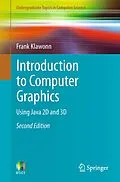A basic understanding of the key techniques in computer graphics can open the door to this exciting field and its many applications.
This easy-to-follow textbook/reference introduces the fundamental concepts of computer graphics, integrating both technical background and theory with practical examples and applications throughout. Thoroughly revised and updated, this new edition continues to present a user-friendly approach to creating images and animations, complementing the expanded coverage of topics with extensive usage of example programs and exercises.
Topics and features:
- Provides an ideal, self-contained introduction to computer graphics, with theory and practice presented in integrated combination
- Presents a practical guide to basic computer graphics programming using Java 2D and 3D
- Includes new and expanded content on the integration of text in 3D, particle systems, billboard behaviours, dynamic surfaces, the concept of level ofdetail, and the use of functions of two variables for surface modelling
- Contains many pedagogical tools, including numerous easy-to-understand example programs and end-of-chapter exercises
- Supplies useful supplementary material, including additional exercises, solutions, and program examples, at the associated website http://public.ostfalia.de/~klawonn/computergraphics
This reader-friendly textbook is an essential tool for second-year undergraduate students and above, providing clear and concise explanations of the basic concepts of computer graphics, and enabling the reader to immediately implement these concepts in Java 2D and/or 3D with only elementary knowledge of the programming language.
Autorentext
Dr. Frank Klawonn is a Professor in the Department of Computer Science and Head of the Data Analysis and Pattern Recognition Laboratory at Ostfalia University of Applied Sciences, Germany. He is also Head of the Bioinformatics and Statistics group at the Helmholtz Centre for Infection Research, Braunschweig, Germany. He is a co-author of the Springer textbook Guide to Intelligent Data Analysis.
Klappentext
This book is an essential tool for second-year undergraduate students and above, providing clear and concise explanations of the basic concepts of computer graphics, and enabling the reader to immediately implement these concepts in Java 2D and/or 3D with only elementary knowledge of the programming language. Features: provides an ideal, self-contained introduction to computer graphics, with theory and practice presented in integrated combination; presents a practical guide to basic computer graphics programming using Java 2D and 3D; includes new and expanded content on the integration of text in 3D, particle systems, billboard behaviours, dynamic surfaces, the concept of level of detail, and the use of functions of two variables for surface modelling; contains many pedagogical tools, including numerous easy-to-understand example programs and end-of-chapter exercises; supplies useful supplementary material, including additional exercises, solutions, and program examples, at an associated website.
Inhalt
Introduction
Basic Principles of Two-Dimensional Graphics
Drawing Lines and Curves
Areas, Text and Colours
Basic Principles of Three-Dimensional Graphics
Modelling Three-Dimensional Objects
Visible Surface Determination
Illumination and Shading
Special Effects and Virtual Reality
Useful Links
Example Programs
References to Java 2D Classes and Methods
References to Java 3D Classes and Methods
